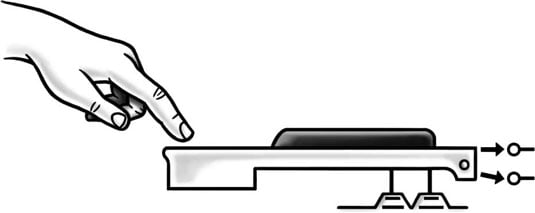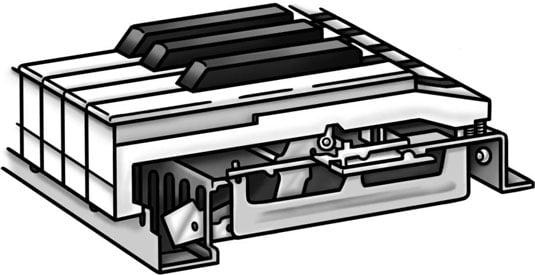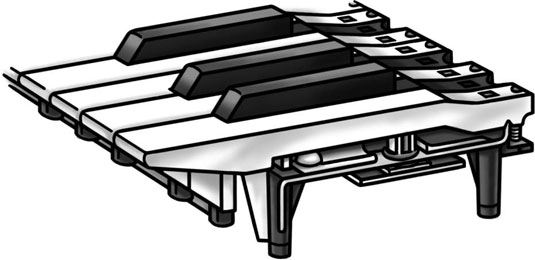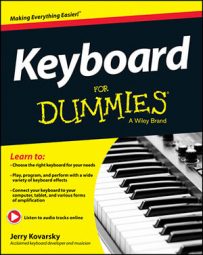The design, feel, and touch of the key mechanism (commonly called the key action) used on modern keyboards can vary a great deal. Understanding how key actions work and what each offers can help you differentiate among the various types of keyboards and models offered.
Touch sensitivity
Key actions come in two main classes: dynamic (touch-sensitive or velocity-sensitive) and non-dynamic. The term dynamics in music refers to changes in loudness or volume.
A velocity-sensitive key action responds to how firmly or softly you play the key, transferring that energy to the sound-producing mechanism to allow you to play many different volume levels from soft to loud. Non-dynamic keyboards have keys that are simple on/off switches that cause the sound to play.
You create dynamics by using a foot pedal, not by varying the touch of your fingers on the keys.
The acoustic piano is velocity-sensitive and can produce an incredibly wide range of dynamics. The Rhodes and Wurlitzer electric pianos and the clav are also velocity-sensitive, although they have narrower ranges of dynamics. The pipe organ, all combo/console/theatre organs, and the harpsichord, on the other hand, aren’t velocity-sensitive. Early analog synthesizers used organ keyboards, so they too were non-dynamic.
Later high-end analog synthesizer models added touch sensitivity; examples include the Yamaha CS-80, Sequential Circuits Prophet T8, and Moog Polymoog and Polymoog Keyboard. But the advent of digital synthesis and MIDI made velocity-sensitive synthesizers and keyboards much more common.
Velocity-sensitive synthesizers have two sensors; the first is at the top of the key, where the key sits when at rest. The other is at the bottom of the key action, where the key reaches when pressed down fully. The system uses these sensors to measure how quickly the key moves from the top to the bottom and then translates that speed or value into a dynamic level.
The idea is that the harder you press a key, the faster it actually moves downward. So soft touch is actually a slow depression of the key, and hard touch is a faster movement.

The terms velocity-sensitive and touch-sensitive are often used interchangeably, but velocity sensitivity is the truly correct term for today’s electronic keyboards because it’s how MIDI translates the playing force into different values.
Key weight
A few types of keys are available to be used on keyboards, some lighter and others heavier to the touch.
Key weight has nothing to do with the dynamics of the key mechanism. Any type of key can be velocity-sensitive, regardless of which of the following weight classes it falls into:
Fully weighted: A weighted or fully weighted key imitates the mass of the piano key action. Both acoustic piano keys and high-end digital piano keys are made of wood with a coating or veneer on top.
The keys have a certain amount of weight to them, so your finger exerts more energy to make them move. This resistance gives you more feedback when you’re trying to play dynamically, and that allows for more nuanced control of soft dynamics. (That control is why serious pianists prefer weighted keys). The key has a slightly protruding top front lip and is enclosed on the front surface.

Semi-weighted: Semi-weighted keys provide a middle ground between weighted and non-weighted key mechanisms for synth actions. Some manufacturers add some weight to the non-weighted synth key or plastic piano-shaped key to increase its mass and make it feel a bit more solid to the touch. It usually has a spring in the mechanism to provide resistance to your touch.
Non-weighted: Non-weighted or synth-action keys are the lightest, simplest action. They often have some spring in the mechanism to add some slight resistance — just enough to keep them from feeling loose and uncontrollable. Simpler plastic keys used on combo organs and synthesizers have little mass, or resistance, to them, so they can be played very easily and often more quickly.
This key is made entirely of plastic and looks more like a diving board with no front edge. Non-weighted keys are preferred by non-pianists and for playing organ, clav, and synth sounds, which aren’t called upon to reproduce that wide a range of dynamics. Yes, they’re played dynamically, but not to the same degree as is expected from the acoustic piano.


